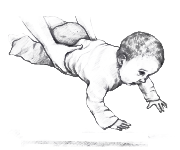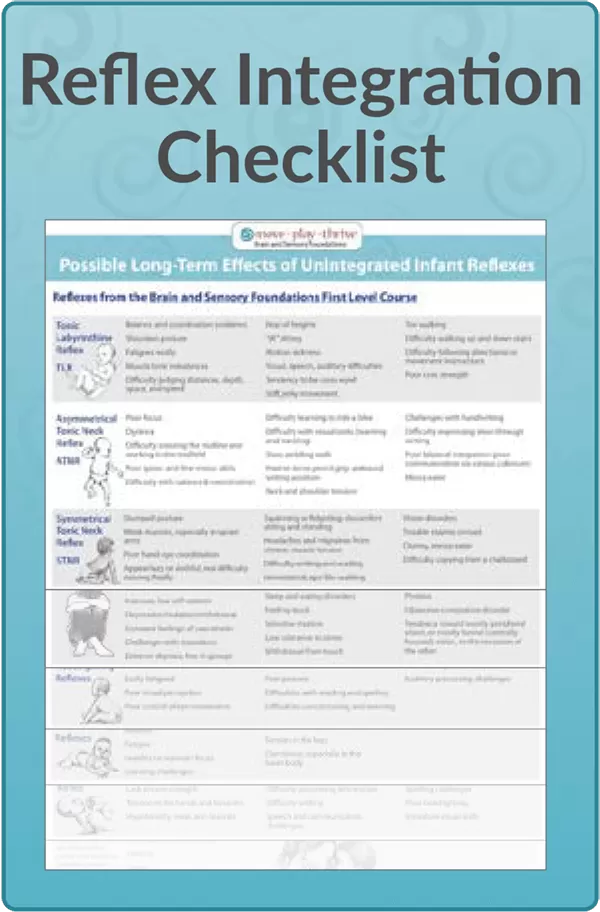Parachute Reflex
 The Parachute reflex, sometimes called Hands Supporting Reflex, is a protective response that in optimal development emerges between 8-12 months of age. When tipped forward, the infant brings the arms and hands out in front of the body to provide protection against falling face-first towards a surface. As the Parachute reflex develops, it protects the infant in both sitting and standing positions from vertical or horizontal surfaces, including surfaces located to the side of or behind the body.
The Parachute reflex, sometimes called Hands Supporting Reflex, is a protective response that in optimal development emerges between 8-12 months of age. When tipped forward, the infant brings the arms and hands out in front of the body to provide protection against falling face-first towards a surface. As the Parachute reflex develops, it protects the infant in both sitting and standing positions from vertical or horizontal surfaces, including surfaces located to the side of or behind the body.
Once developed, this reflex is meant to persist throughout life to provide postural stability and protection when falling, regardless of the direction the individual is falling in. Individuals who do not attempt to break their fall may be lacking the Parachute reflex.
The Parachute reflex also supports the head to be in midline even when the body moves. For this reason, developing the Parachute reflex is an important part of addressing infant torticollis. Additionally, the Parachute reflex helps to mature the muscles and gross motor abilities of the hands and arms. It contributes to the development of visual perspective, hand-eye coordination, and the neuro-sensory-motor pathways that link the hands, arms, and brain.
As with many reflexes, the Parachute reflex can impact emotions, particularly feelings of safety. A well-established Parachute reflex contributes to our ability to know and set personal boundaries. When this reflex is underdeveloped, children and adults may subconsciously feel unable to protect themselves, leading to stress and anxiety that can interfere with learning.
Possible Long-Term Effects of an Underdeveloped Parachute Reflex include:
- Prone to injuries of the head and upper body
- Disruption of Headrighting reflexes development
- Poor arm and hand coordination
- Difficulty establishing boundaries
- Inability to say “no”
- Tendency towards isolation from others
- Aggression, bullying OR prone to being bullied
- Difficulty processing stress and new information
- Challenges with expressive communication
- Learning delays
- Amphibian Reflex
- Asymmetrical Tonic Neck Reflex
- Birth and Bonding
- Crawling Reflexes
- Crossed Extensor Reflex
- Facial-Oral Reflexes
- Fear Paralysis Reflex
- Feet Reflexes—Plantar & Babkinski
- Foot Tendon Guard
- Hand Reflexes—Grasp, Palmar, and Babkin
- Headrighting Reflexes
- Infant Torticollis
- Landau Reflex
- Moro Reflex
- Parachute Reflex
- Pull-to-Sit Reflex
- Spinal Galant Reflex
- Spinal Perez Reflex
- Symmetrical Tonic Neck Reflex
- Tonic Labyrinthine Reflex
Sources
betapicts. (2019, February 19). Baby - parachute reflex /reaction, at 3 weeks & 10 months [Video]. YouTube. https://www.youtube.com/watch?v=tJ1_a1FGFs4
Blomberg, H. (2007, July). Rhythmic Movement Training Levels 1, 2 and 3 [Lecture]. Phoenix, Arizona.
Masgutova, S. (2007). Integration of infant dynamic and postural reflex patterns: Neuro-sensory-motor and reflex integration method [Training manual].


